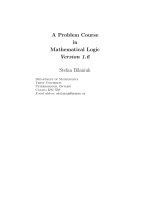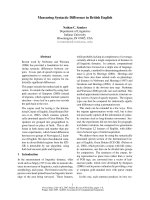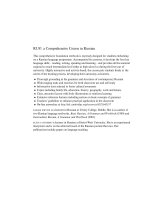A practical course in british english pronunciation
Bạn đang xem bản rút gọn của tài liệu. Xem và tải ngay bản đầy đủ của tài liệu tại đây (1.91 MB, 0 trang )
A Practical Course in
British English Pronunciation
The
Sound
of
3
CDs
e-book
+
audio
English
by Joseph Hudson
“All the tricks you need to sound like a native speaker.”
Javier Fernandez Pena
self-study or classroom use
9 chapters with answer key
How to Use this E-Book
‘The Sound of English’ is a fully interactive pdf with the following features:
•Audio: click on the icons next to each activity to hear the audio.
•Index: click on the page you require to go straight there.
•Answer Key: click on the question mark to go straight to the answers.
Sentence Stress | Intonation
Audio appears with this symbol
click it to hear the file.
- Listen to the following exchange.
A “What would you like?”
B “A cup of tea.”
2.16
Explanations appear in grey boxes.
?
- Which words are stressed?
- Of the stressed words, which words are strongest?
!
In spoken English we stress content words.
!
One word in every sentence is more stressed than the others.
!
Normally the last content word is the most stressed word.
EXERCISE
Exercises should be completed
then checked in the answer key.
- Match the content words on the left with the content words on the right.
pair
pint
leg
Answer Key is linked to by
clicking the red question mark.
a
?
bunch
bag
glass
book
beef
bread
poems
of
joint
loaf
wine
shoes
milk
flowers
lamb
crisps
?
DRILL
Drills should be repeated with
the audio until produced accurately.
- Repeat the rhythm followed by each sentence from the exercise:
2.17
.x.X
. x . X | a pair of shoes
Visit us at www.thesoundofenglish.org for more
activities, news and course info!
Follow us on Facebook & Twitter for updates:
© Joseph Hudson 2012
Introduction
!!!
'') ' Y'+
Sounds
- Consonants
- Vowels
Spelling & ‘ghoti’
Sound Schwa
Structure Function & Content
Intonation
Patterns
Usage
/!pɜ:sənli/
Postscript IPA
Answer Key Pages 113-114
4
© Joseph Hudson 2012
Consonant Types | Sound
✦
Consonant sounds are produced by blocking air as it leaves the mouth.
✦
This course shows you how to pronounce all 25 consonant sounds of English.
✦
Below is an example of each consonant sound - listen and read them.
Type of Sound
Sound
Example 1
Example 2
p
pin
cap
b
bag
robe
t
time
late
d
door
feed
k
cash
sock
0.1
plosive
(complete block of air followed
by explosion)
g
ʔ
girl
-
flag
football
f
full
knife
v
vest
cave
θ
think
earth
ð
those
bathe
s
sight
kiss
z
zoo
nose
ʃ
shirt
crash
ʒ
-
pleasure
h
high
-
affricate
tʃ
chose
catch
(plosive followed by fricative)
dʒ
joy
stage
nasal
m
mood
calm
n
now
turn
ŋ
-
bang
w
wall
-
j
yellow
-
r
room
-
l/ɫ
law
pill
fricative
(constant flow of air “squeezed”
through a block, sounds like
friction)
(air is released through the nose)
approximant
(vowel-like consonant, no full
block of air occurs)
5
© Joseph Hudson 2012
Consonant Articulation | Sound
We use the articulators: tongue, lips & teeth, to block air.
✦ The places where we block air in English are shown below.
t lY
✦
tool
alveolar ridge
velum
lips
teeth
palate
tongue
glottis
EXERCISE
k/g/ŋ
m/p/b
-f<
q
f/v
tool
C,e ,;1
4.
t/d/l/n
t lY
Af
θ/ð
'') ' Y'+
1.
- Listen to the recording and match the sounds in the boxes with their articulation
diagrams (number 1 has been done). The arrows point to the place of articulation.
2.
3.
wl il)
0.2
h/ʔ
6.
5.
- Check your answers in the answer key on page 112.
6
© Joseph Hudson 2012
Vowels | Sounds
✦
✦
✦
✦
A neutral English accent has 19 vowel sounds.
There are 3 types of English vowel sound - short, long and diphthong.
English spelling does not always show us which sound to pronounce.
We will learn how to pronounce each individual vowel sound on this course.
Type of Sound
0.3
short
(single mouth
position)
long
(single mouth
position)
diphthong
(double mouth
position)
Sound
Spellings
Examples
ə
a, e, o, u
alive, the, today, supply
ɪ
i
thin, sit, rich
ʊ
u, oo, ou
put, look, should
e
e, ea, ie
went, bread, friend
ʌ
u, o
fun, love, money
æ
a
cat, hand, fan
ɒ
o, a
rob, top, watch
i:
ee, ea
need, beat, team
u:
ew, oo, o_e
few, boot, lose
ɜ:
ir, ur, wor
third, turn, worse
ɔ:
al, aw, or, our, oor
talk, law, port
ɑ:
a, al, ar
glass, half, car
eɪ
ay, ea, ae, ai
pay, great, maid
ɔɪ
oi, oy
noise, toy, choice
aɪ
ie, i_e, i, y
fine, like, might
əʊ
o, o_e, oa
no, stone, road
aʊ
ou, ow
round, how, brown
ɪə
eer, ear
beer, hear, steer
eə
are, ere, ea, ai
care, there, bear
7
© Joseph Hudson 2012
Vowel Articulation| Sounds
✦
A vowel sound is made by shaping the mouth as air flows out.
✦
Articulators used to shape the mouth are: tongue, lips and jaw.
✦
The chart below shows examples of mouth positions in English.
Position
0.4
tongue
Example
lips
jaw
y-,C"rL
y-,C"rL
>rr"f
,na1
,na1
)
)
>rr"f
front
spread
close
centre
relaxed
mid
back
rounded
open
i: (keep)
ɜ: (bird)
y-,C"rL
,na1
>rr"f
)
ɒ (watch)
DRILL
- Repeat the following sentences. Notice your jaw opening each time.
0.5
1. Keep this red bag. 2. Who took Paul’s watch?
3. The bird runs fast.
- Which sentence contains only rounded vowels?
8
© Joseph Hudson 2012
Introduction | Spelling & Sound
0.6
- English spelling does not always indicate pronunciation.
- It was famously claimed that the word ‘fish’ could be spelt ‘ghoti’ because:
‘gh’ in ‘enough‘ is pronounced /f/
‘o’ in ‘women’ is pronounced
/ɪ/
‘ti’ in ‘motion’ is pronounced /ʃ/
so ‘ghoti’ could be pronounced /fɪʃ/!
✦
✦
The pronunciation of many English sounds can be predicted by their spelling.
The ‘Spelling & Sound’ section shows you how to select sounds accurately by
interpreting spelling.
EXERCISE
- Each group of words contains an identical spelling.
- Circle the word that you think is pronounced differently from the others.
loose
1. goose
2. nose
rose
3. played
author
5. paid
maid
but
7. none
0.7
lose
stopped
4. father
6. put
choose
liked
Northern
said
hut
done
gone
8. foot
book
food
9. slow
now
cow
10. word
work
11. watch
wall
worn
was
- Listen and check your answers.
9
© Joseph Hudson 2012
Schwa | Spelling & Sound
- Match the words below with the IPA transcription on the right:
Word
around
0.8
IPA Transcription
!mænə
6
manner
!seɪlə
sailor
!kæktəs
cactus
ə!raʊnd
- Which sound appears in every IPA transcription?
0.9
✦
The schwa sound /!/ can be spelt as < a >, < e >, < o > and < u >.
✦
The schwa is the most common vowel sound in English.
✦
The schwa is weak - it can never be stressed.
✦
The production of the schwa is neutral: lips, jaw and tongue are relaxed.
EXERCISE
- Every word in the box below contains one schwa sound.
- Listen to the recording and underline the schwa in each word.
0.10
servant
bacon
_ persist
_
_ picture commit alive
jumper sublime London salad Peru structure
suggest soldier persuade combine balloon
terror cushion scripture tighten sofa Russia
- Think of any word in English with 3 syllables or more.
- How many schwa sounds does it contain? Check in a dictionary.
EXAMPLE: ‘conspiracy’ = 2 schwa sounds.
10
© Joseph Hudson 2012
The Sound of English
Full Version
140 pages | 200 audio files
Available as a book + 3CDs, ebook & iBook.
Purchase
Function & Content | Structure
- Listen to the sentence below:
“Shall we go for a walk?”
0.11
- Which words are stressed? Why?
✦
Spoken English is divided into function and content words.
✦
Function words carry only grammatical meaning, such as:
Word Type Examples
prepositions
auxiliaries
articles
quantifiers
pronouns
✦
to from for of with by
are was do have could would shall can
a an the
some any few all
he she it you I this that
Content words carry real meaning such as:
Word Type Examples
nouns
verbs
adjectives
adverbs
car wedding James table joy
move drink turn enjoy think
big interesting quiet slow bright
quickly quietly fortunately often again
EXERCISE
- In the sentences below, underline the function words:
0.12
1.
2.
3.
4.
5.
6.
Can we go for a swim in the sea?
It’s a beautiful day in the South of England.
How do you want to pay for this, sir?
Jessica Smith is required in ‘Arrivals’ immediately.
When you get to the station, give me a call.
Would you like some of my carrot cake?
11
© Joseph Hudson 2012
Schwa Function Words | Structure
- Read and listen to the passage below, the schwa sound is written in IPA:
I’d like t! go shopping f!r ! pair !f shoes, b!t th!
shops ! closed bec!se th!s ! weath!r !lert. !parr!ntly
lots !f snow is coming in fr!m th! Highl!nds so th!
gov!rnm!nt h!v !dvised peop!l t! stay !t home.
0.13
- Which function words are pronounced with a schwa sound in the passage?
✦
Many function words are pronounced with schwa when they are weak.
✦
If a function word is stressed, it can not be pronounced with schwa.
✦
Function words are always strong when said alone.
DRILL
- Say the word on the left alone (strong), then say it in the sentence on the right using
the schwa sound (weak):
Word Sentence
(STRONG) (WEAK)
0.14
1
to /tu:/
I went to work early. /tə/
2
are /ɑ:/
What are you doing? /ə/
3
was /wɒz/
4
from /frɒm/
This cardʼs from my family. /frəm/
5
there /ðeə/
There werenʼt enough drinks. /ðə/
6
can /kæn/
Where can we buy a map? /kən/
7
her /hɜ:/
Her carʼs broken down. /hə/
8
for /fɔ:/
Iʼll repeat for the last time! /fə/
Was it warm in Greece? /wəz/
12
© Joseph Hudson 2012
Introduction | Intonation
- Listen to the following question being answered in three different ways:
A Johnny, have you finished
your homework?
0.15
1. ↘Yes
B 2. ↘Yes
3. Yes
- Which answer (B) means i) maybe ii) definitely iii) why are you asking me?
✦
Spoken English uses 3 intonation patterns - fall, fall-rise & rise.
✦
Intonation shows us the speaker’s attitude to what they are saying.
DRILL
- Repeat after the recording:
0.16
1. a)↘Yes b)↘Yes c)Yes
2. a)↘No b)↘No c)No
EXERCISE
- Listen to the conversations and circle the answer you hear:
0.17
1. Are you married?
Yes ↘ ↘
2. Did you enjoy the film?
Yes ↘ ↘
3. Can you afford this meal?
Yes ↘ ↘
4. You’re drunk, aren’t you?
No ↘ ↘
5. Is this your first class?
No ↘ ↘
6. Did you eat all the chocolate? No ↘ ↘
13
© Joseph Hudson 2012
Usage | Intonation
✦
Intonation shows us a speaker’s attitude to their words.
✦
This course will show you how to produce English intonation in your speech.
✦
Some important examples of intonation usage are displayed below.
EXERCISE
1. ATTITUDE
- Listen to the following conversation twice:
0.18
A “Dad, I’ve got some news, I’m getting married!”
B “Excellent”
i) How is the father’s reaction different in each case?
ii) How does he show this with intonation?
2. IMPLICATION
- Listen to the following conversation twice:
0.19
A “What did you think of the film?”
B “It was good.”
i) What is the difference in meaning between the two versions?
ii) How is the intonation in the word ‘good’ different the second time?
3. REPETITION
Listen to the following conversation:
0.20
A “Who are you meeting tonight?”! B “Nicole Kidman.”
A “Who are you meeting tonight?”! B “Not the Nicole Kidman!”
- Person A says the same question twice, but the intonation is different the second
time. How does it change and why?
14
© Joseph Hudson 2012
IPA | Postscript
- Look at the dictionary entry for the word “personally”:
personally /!pɜ:sənli/
- What differences do you notice between the spelt and the IPA versions?
IPA (International Phonetic Alphabet) shows the way we pronounce words.
In English, the pronunciation of a word often differs from its spelling, making
IPA a very useful study tool to improve your pronunciation.
✦
✦
✦
Stress is marked in IPA using the symbol / ˈ/.
EXERCISE
i) Write the words from the box below into the chart next to their IPA transcription.
ii) Write the silent consonant from each word into the 3rd column.
cupboard island half often write know light lamb handbag autumn
0.21
Word
IPA
Silent Consonant(s)
1
autumn
ˈɔ:t#m
n
2
half
hɑ:f
l
3
læm
4
n#ʊ
5
ˈaɪl#nd
6
laɪt
7
ˈkʌb#d
8
raɪt
9
ˈɒf#n
10
ˈhænbæg
- Listen to the recording to check your answers and practise saying the words.
15
© Joseph Hudson 2012
Study with the teachers who made ‘The Sound of English’
in London and online. Start with a free schwa class, an
individual assessment or an online taster.
Courses
Answer Key | Introduction
Consonant Articulation | Sounds
EXERCISE
1. f/v 2. t/d/l/n
3. m/p/b
4. k/g/ŋ
5. θ/ð
6. h/ʔ
EXERCISE
- sentence 2 ʻWho took Paulʼs watchʼ uses only rounded vowels.
Introduction | Spelling & Sound
EXERCISE
1. choose 2. lose
9. slow 10. worn
3. played
11. wall
4. author
5. said
6. put
7. gone
8. food
Schwa | Spelling & Sound
- around /əˈraʊnd/, manner /ˈmænə/, sailor /ˈseɪlə/, cactus /ˈkæktəs/
- /ə/ appears in every IPA transcription (in bold above).
EXERCISE
servant persist bacon picture commit alive
jumper sublime London salad Peru structure
suggest soldier persuade combine balloon
terror cushion scripture tighten sofa Russia
Function & Content | Structure
- ʻgoʼ and ʻwalkʼ are stressed because they carry meaning.
- The other words ʻshallʼ, ʻweʼ, ʻforʼ, & ʻaʼ are all grammatical words used to gel the
sentence.
EXERCISE
1. Can we go for a swim in the sea?
2. Itʼs a beautiful day in the South of England.
3. How do you want to pay for this sir?
4. Jessica Smith is required in ʻArrivalsʼ immediately.
5. When you get to the station, give me a call.
6. Would you like some of my carrot cake?
Schwa Function Words | Structure
- Function words pronounced with schwa in the passage: ʻtoʼ, ʻforʼ, ʻaʼ, ʻofʼ, ʻbutʼ, ʻtheʼ,
ʻareʼ, ʻthereʼ, ʻaʼ, ʻhaveʼ, ʻatʼ.
Introduction | Intonation
- i) ʻMaybeʼ = ↘yes
ii) ʻDefinitelyʼ = ↘yes
EXERCISE
1. ↘ 2. ↘
4.
3.
5.
↘
iii) ʻWhy are you asking?ʼ =
yes.
6. ↘
113
© Joseph Hudson 2012
Answer Key | Introduction
Usage | Intonation
EXERCISE
1. ATTITUDE
i) In the first version, the father is excited and interested, in the second he is
uninterested and a little rude.
ii) The fatherʼs intonation is falling in both examples, the main difference is that he
starts from a much higher pitch in the first example. This shows more emotion. In the
second version, he starts his phrase quite low, showing disinterest.
2. IMPLICATION
i) In the first version, we understand that person B really felt the film was good. In the
second version, he is not entirely sure, he is showing reservation, we are expecting him
to say something less positive now.
ii) In the first version, person B uses falling intonation on ʻit was goodʼ, whereas in the
second version he uses fall-rising intonation, known as an implicational fall-rise.
3. REPETITION
- The first question is asking for new information, person A does not know the answer
and uses falling intonation. The second time she asks, she already knows the answer,
she is repeating the question and for this reason uses rising intonation.
IPA | Postscript
- The IPA version shows us a silent < r >, a long vowel /:/ and a silent < a >. It also
indicates the pronunciation of the vowels /ə/ and /i/.
EXERCISE
1
autumn
ɔ:təm
n
2
half
hɑ:f
l
3
lamb
læm
b
4
know
nəʊ
k (and w)
5
island
aɪlənd
s
6
light
laɪt
gh
7
cupboard
ˈkʌbəd
p (and r)
8
write
raɪt
w
9
often
ɒfən
t
10
handbag
hænbæg
d
114
© Joseph Hudson 2012









